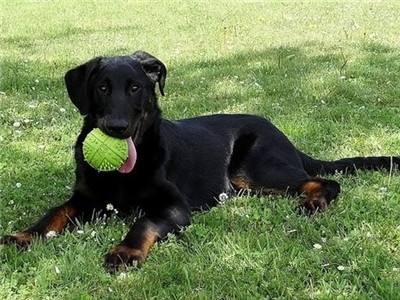Beauceron
IUCN
LCBasic Information
Feature
The French Wolfhound looks a bit like a Doberman Pinscher. They are smart, brave, loyal, and eager to work. They are good guard dogs and herding dogs.
Distribution and Habitat
Originated in the 16th century, it was produced in France. It was first used to hunt wild boars, and later turned to sheep herding. It was even used to transmit messages during wartime.
Appearance
The French Mastiff appears large, muscular, powerful, and fearless. It is not heavy, but has a long head with a flat or slightly domed skull. It has a long muzzle, a black nose, and folded ears (upright ears are now accepted). The neck is strong and powerful. The feet are round with black nails. There is a vestigial toe on the hind legs. The French Mastiff has a short but thick coat, which is close and smooth, except for some longer, hanging edges on the legs, underside of the tail, and flanks. The standard coat colors are black and tan, black, and parti-colored. The once popular colors of tan (brown), gray, and gray and black have been abandoned by the standard. Most are reddish-brown above the eyes, throat, chest, limbs, and underside of the tail.
Details
Although other countries don't know much about the French Wolfhound, it is indeed a very old purebred dog bred in France. Named after the Beauce region of France.

The French Wolfhound was first described in documents in 1587. In 1809, a priest first described the difference between the French Wolfhound and the Briard in an article. In the late 19th century, farmers who raised cattle and sheep held a meeting and decided to name the long-haired dog as the Briard and the short-haired dog as the Beauceron (French Wolfhound). In the late 19th century, Paul Morgan began to study the identification between the two and formulated the identification standard of the French Wolfhound. In 1922, the French Wolfhound Club was established under Morgan's leadership. The French Wolfhound standard has been revised 6 times in 100 years, and the last revision was in 2001 and took effect on November 29 of that year.
Since the 1960s, the French Wolfhound has been widely raised in France, but has only recently become popular in many foreign countries, including the United States. The most attractive thing is their appearance and personality. French writers even labeled him "French gentleman".
The French Wolfhound is a widely used breed. It was once used to hunt wild boars and played three roles for a long time: herding dog (herding cattle and sheep, etc.), guard dog and family guard dog. In the two world wars in Europe, it was also used by the military to transmit information, carry supplies, detect mines, rescue the wounded, etc. Today they are still excellent military and police dogs, and also used as family guard dogs and companion dogs.
The French Wolfhound is fearless, bold and vigilant, and very brave. It can live in peace with other animals such as dogs and cats it knows. It has a balanced and stable personality that does not change throughout its life. Once it adapts to its owner and his family, it is absolutely loyal and always ready to listen to the owner's orders. It is as closely connected to the family as a family member. It is very brave and takes it as its responsibility to protect the family and property, and dares to challenge any intruder. It executes commands quickly and agilely, and is very sensitive to the owner's emotions. It is very serious about the assigned work. It is not happy to stay in the kennel. It will control itself in front of children. The French wolfhound is calm and peaceful, and very docile. It has a high IQ and super memory. The French wolfhound is surprisingly sensitive to the owner's commands, so many people think that it has a spiritual connection with the owner. Due to the nature of the French wolfhound, it should be trained to obey social requirements as early as possible.
French wolfhounds are like other wolfhounds. Once they are angry, they are extremely ferocious, so pay attention to training.
Protect wild animals and eliminate game.
Maintaining ecological balance is everyone's responsibility!








